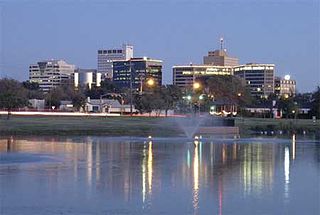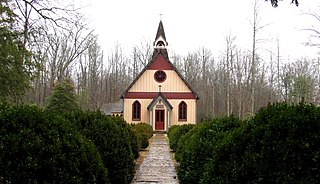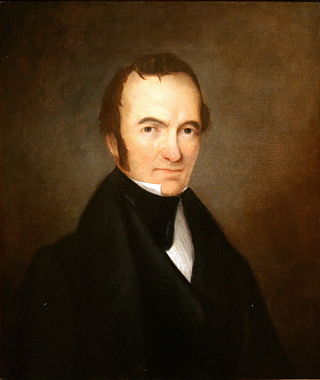Notes
- 1 2 3 Belle Plain College: Handbook of Texas Online, University of Texas at Austin.
- ↑ Plaque at site of Belle Plain College
| Active | 1881–1892 |
|---|---|
| Location | , |
Belle Plain College, established in 1881, was a short-lived college located in the now defunct town of Belle Plain, Texas. The college was established by the Northwest Conference of the Methodist Church.
John Day donated 10 acres (40,000 m2) of land to the school, located in Belle Plain. In its beginnings local citizens donated generously to the institution. During its first year of existence, 1881–82, it operated in conjunction with the Belle Plain public school system. Franklin Wesley Chatfield served as Belle Plain College (BPC) president during most of its inaugural year. In the spring of 1882 the state awarded BPC a charter and Rev. J.T.L. Annis served as president of the college for the next two years. During his tenure enrollment increased to 122.
Other presidents of BPC include: John W. McIllhenny (1884–85), C. M. Virdel (1885-87), and I.M. Onins (1887–92). [1]
From its inception the college boasted of its music program. By the end of the 1880s the school had fifteen pianos, a brass band, and an orchestra. Though the campus comprised two buildings by 1885 the entire school had been mortgaged to pay for classroom furnishings and instruments. The school's only funding came from the local school district, a fact which hastened its demise. [1]
Upon founding, the school had a girl's dormitory constructed. At the college's height over 300 people were enrolled and in 1885 a three-story stone structure was built at the site. BPC had a military branch of its school in the small town of Belle Plain. The students there were required to wear blue and gray uniforms. [2]
When the railroad skipped over Belle Plain in favor of Baird the latter quickly gained favor and became the county seat of Callahan County in 1883. The population began to decline as a result. A couple years of bad weather depleted the college's already empty coffers. Judge I.M. Onins took over the school and its debts in 1887. The mortgage company foreclosed on the property in 1889, though they allowed it to operate until Onins' 1892 death. Today the ruins of the college buildings remain. [1]

Hendry County is a county in the Florida Heartland region of the U.S. state of Florida. As of the 2020 census, the population was 39,619, down from 42,022 at the 2010 census. Its county seat is LaBelle.

Clinton is a village in Oneida County, New York, United States. The population was 1,942 at the 2010 census, declining to 1,683 in the 2020 census 13% decline). It was named for George Clinton, the first Governor of New York.

Salado is a town in Bell County, Texas, United States. Salado was first incorporated in 1867 for the sole purpose of building a bridge across Salado Creek. In 2000, the citizens of Salado voted in favor of reincorporation, before which it was a census-designated place. The population was 2,394 at the 2020 census.

Midland is a city in and the county seat of Midland County, Texas, United States. A small part of Midland is in Martin County. The population was 132,524 as of the 2020 census. Located in the Permian Basin in West Texas, Midland is a major center for American oil and natural gas production.

Rugby is an unincorporated community in Morgan and Scott counties in the U.S. state of Tennessee. Founded in 1880 by English author Thomas Hughes, Rugby was built as an experimental utopian colony. While Hughes's experiment largely failed, a small community lingered at Rugby throughout the 20th century. In the 1960s, residents, friends and descendants of Rugby began restoring the original design and layout of the community, preserving surviving structures and reconstructing others. Rugby's Victorian architecture and picturesque setting have since made it a popular tourist attraction. In 1972, Rugby's historic area was listed under the name Rugby Colony on the National Register of Historic Places as a historic district.

West Texas A&M University is a public university in Canyon, Texas. It is the northernmost campus of the Texas A&M University System and accredited by the Southern Association of Colleges and Schools (SACS). It was established on September 20, 1910, as West Texas State Normal College as one of the seven state-funded teachers' colleges in Texas.

Lakeshore is a municipality on Lake St. Clair, in Essex County, Ontario, Canada. It was incorporated in 1999 by amalgamating the Town of Belle River with the townships of Maidstone, Rochester, Tilbury North, and Tilbury West. It is the largest and the most populous municipality within Essex County. However, it is part of the Windsor census metropolitan area.
University of Nashville was a private university in Nashville, Tennessee. It was established in 1806 as Cumberland College. It existed as a distinct entity until 1909; operating at various times a medical school, a four-year military college, a literary arts college, and a boys preparatory school. Educational institutions in operation today that can trace their roots to the University of Nashville include Montgomery Bell Academy, an all-male preparatory school; the Vanderbilt University Medical School; Peabody College at Vanderbilt University; and the University School of Nashville, a co-educational preparatory school.

The Fort Worth and Denver Railway, nicknamed "the Denver Road," was a class I American railroad company that operated in the northern part of Texas from 1881 to 1982, and had a profound influence on the early settlement and economic development of the region.

After declaring its independence from Mexico in March, 1836, the Republic of Texas had numerous locations as its seat of government. This being seen as a problem attempts were made to select a permanent site for the capital. January, 1839, with Mirabeau B. Lamar as the newly elected president, a site selection commission of five commissioners was formed. Edward Burleson had surveyed the planned townsite of Waterloo, near the mouth of Shoal Creek on the Colorado River, in 1838; it was incorporated January 1839. By April of that year the site selection commission had selected Waterloo to be the new capital. A bill previously passed by Congress in May, 1838, specified that any site selected as the new capital would be named Austin, after the late Stephen F. Austin; hence Waterloo upon selection as the capital was renamed Austin. The first lots in Austin went on sale August 1839.

Minnesela is a ghost town and was the first settlement in and county seat of Butte County, South Dakota, United States. Minnesela was founded in 1882 and was located three miles southeast of present-day Belle Fourche. The railroad's decision to bypass Minnesela and to continue on to Belle Fourche in 1890 caused the town to be abandoned by 1901.

Briarcliff College was a women's college in Briarcliff Manor, New York. The school was founded as Mrs. Dow's School for Girls in 1903 at the Briarcliff Lodge. After Walter W. Law donated land and a building for the college, it operated at its location at 235 Elm Road in Briarcliff until 1977; closing due to low enrollment and financial problems. Pace University subsequently operated it as part of its Pleasantville campus from 1977 to 2015. In an effort to consolidate its campuses, Pace University sold the campus in 2017 to the Research Center on Natural Conservation, a host of conferences relating to global warming and conservation. The campus was again sold in 2021, to a Viznitz Yeshiva congregation.
Belle Plain is a populated place in Callahan County, Texas, United States.

Salado College was a college in Salado, Texas, United States that operated from 1860 until 1885.

Guadalupe College was a private Baptist college for African Americans in Seguin, Texas. It was established in 1884 and opened officially in 1887. Its founding was chiefly due to the efforts of William B. Ball, who later became its president. David Abner Jr. was president of Guadalupe College from 1891 to 1906, a 15-year tenure during which the college flourished and gained statewide recognition. At its height during his administration, the college had an enrollment of approximately 500 students.

Soule University was a private Methodist university in Chappell Hill, a rural community in Washington County, Texas, United States. Chartered in 1856 and named after Bishop Joshua Soule, the school replaced the male department of Chappell Hill Male and Female Institute and was intended to succeed the struggling Rutersville College. Soule was beset by financial challenges after the American Civil War and two epidemics of yellow fever, leading the Methodist Church and Soule's president to form Southwestern University as a replacement in 1873. Despite the Texas Legislature transferring Soule's charter to Southwestern in 1875, local supporters kept Soule open until 1887 under the name Soule College.
Amphion is an unincorporated community in Atascosa County, in the U.S. state of Texas. According to the Handbook of Texas, the community had a population of 26 in 2000. It is located within the San Antonio metropolitan area.

The Naperville Historic District is a set of 613 buildings in Naperville, Illinois. Of these 613 buildings, 544 contribute to the historical integrity of the area. The district represents the town as it was originally platted and a few early additions.
Chappell Hill Female College was a private college in Chappell Hill, a rural community in Washington County, Texas, United States. It was founded in 1850 as part of the coeducational school Chappell Hill Male and Female Institute. First chartered by the Texas Legislature in 1852 as a non-denominational preparatory school, the charter was amended to affiliate the school with the Methodist Church in 1854, and was rechartered as a women's college after the male department was spun off as Soule University in 1856. It was closed in 1912 and the building became a public school until a replacement was built in 1927 that preserves the college's bell. The site was added to the National Register of Historic Places in 1985.

139–141 George Street are heritage-listed former terrace houses and now shops located at 139–141 George Street in the inner city Sydney suburb of The Rocks in the City of Sydney local government area of New South Wales, Australia. It was built from 1881 to 1882. It is also known as three storey stone building. The property is owned by Property NSW, an agency of the Government of New South Wales. It was added to the New South Wales State Heritage Register on 10 May 2002.